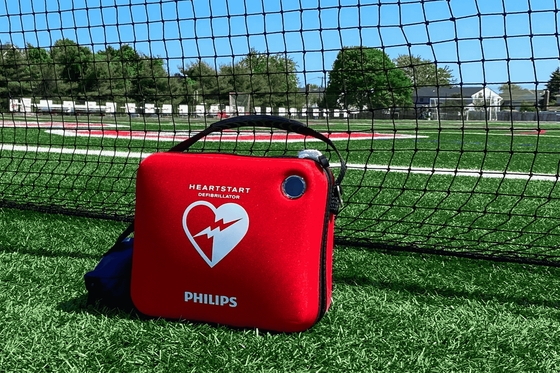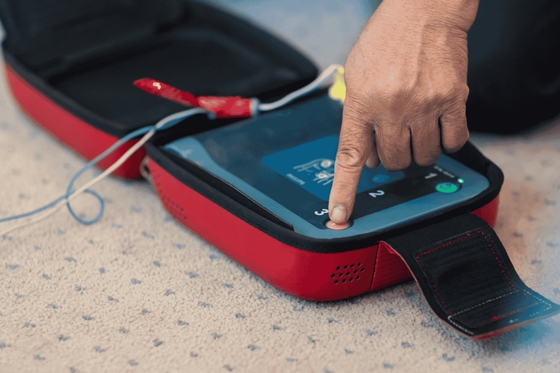
Why Daniel has never been more grateful for a ‘shocking’ day
Daniel Lowe’s gym session started like any other with some light stretches and his favourite playlist. The Adelaide father of three felt well as he settled into his run on the treadmill, totally unaware that just six minutes later he would go into cardiac arrest.
A sudden cardiac arrest is when a person’s heart suddenly stops beating. It usually happens when there is a problem with the heart’s electrical system, causing the heart to stop pumping. This starves the brain and vital organs of oxygen-rich blood.
At 35, Daniel was fit and healthy, with no history of heart problems or major health issues. In the days leading up to his collapse, and even in the moments just before, there were no warning signs at all.
“I just dropped to the ground,” explains Daniel. “My heart stopped, and I wasn’t breathing for over 12 minutes.”
A sudden cardiac arrest is a medical emergency which, sadly, only one in 10 people will survive1. But quick action from bystanders can significantly improve a person’s chance of survival.
Luckily for Daniel, he was in the right place at the right time. Gym staff, including his personal trainer and fellow gym goers, swung into action right away.
“They immediately called Triple Zero, started CPR and used an automated external defibrillator (AED) that thankfully was in easy reach.”
An AED is a portable electronic device that can detect life-threatening abnormal heart rhythms which can cause a cardiac arrest. An AED can help treat these abnormal heart rhythms by giving an electric shock to the heart. They’re easy to use and talk you through the steps you need to take – you don’t need any special training to use one.
The next thing Daniel remembers is waking up in hospital and trying to make sense of what had happened to him.
“I don’t remember receiving CPR or getting shocked by the AED,” says Daniel. “I woke up with a few sore ribs from the CPR, but honestly, it’s a small price to pay. I’m just glad there were people around who didn’t think twice about jumping in to save my life.”
Despite a series of tests, the doctors couldn’t explain why the cardiac arrest had happened in the first place. But to reduce the risk of a future arrest, they inserted an internal cardioverter defibrillator (ICD) into Daniel’s chest. An ICD is a small battery-powered box that can deliver small electrical ‘shocks’ to return a person’s heartbeat to a normal rhythm, reducing the risk of a cardiac arrest.
Thankfully, Daniel’s recovery was a smooth one. “One of the hardest parts of recovery was that I was unable to drive for six months because of the risk of collapsing at the wheel.”
Now, at 44, Daniel is still an avid gym goer. He even manages the very gym where these ‘shocking’ events unfolded. Unsurprisingly, he is also a strong advocate for more AEDs in public places and wants to spread the message that anyone can use these simple devices, even if you’ve never used or seen one before.
“When someone is in cardiac arrest, every minute counts,” reflects Daniel.
Having an easily accessible AED and someone prepared to use it probably saved my life.
Danny Lowe
Cardiac arrest survivor
During a cardiac arrest, an AED makes delivering a life-saving shock simple. Just turn it on and follow the prompts. It’s shockingly simple.
References
- Bray J, Howell S, Ball S et al. The epidemiology of out-of-hospital cardiac arrest in Australia and New Zealand: A binational report from the Australasian Resuscitation Outcomes Consortium (Aus-ROC). Resuscitation. 2022;172:74-83. doi: 10.1016/j.resuscitation.2022.01.011
You might also be interested in...

Anastasia and her son Felix are the best kind of shockers
Read about how quick action and use of an AED by Felix and Anastasia saved a stranger's life at a local soccer field.

It’s shockingly simple to help save a life – just use an AED!
South Australians are being urged to use an Automated External Defibrillator (AED) in the event of a cardiac arrest, with a local campaign launching to highlight how simple AEDs are to use.
.png?width=560&height=auto&format=pjpg&auto=webp)
Our partner: Heart of the Nation
Heart Foundation and Heart of the Nation have joined forces to help improve survival rates from out-of-hospital cardiac arrests.
Last updated10 November 2024